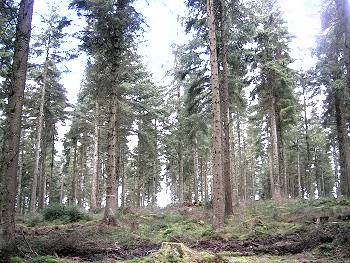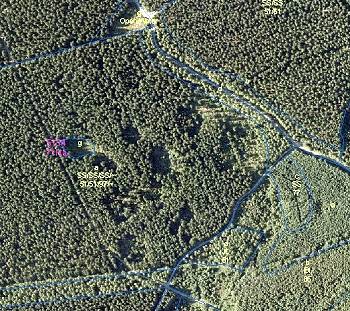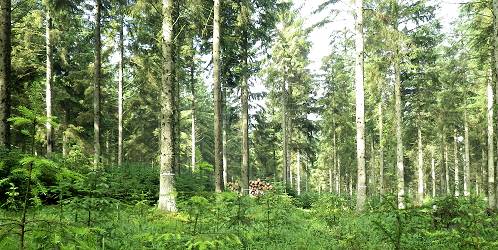
The main focus of this area is to support the Welsh Government’s ‘Woodlands for Wales’ policy and produce evidence and demonstrate alternative methods of forest management to clearfelling.
The Clocaenog CCF Research Area was established by Bangor University and Forest Research in 2002 and has three main objectives:
Background to the Clocaenog CCF Research Area (PDF-660K)
The following information summarises how each of the above objectives is being achieved and, where possible, shows results of the studies that have been completed or are in progress.
The structure of the area is that it contains five large plots each of which is managed using a different silvicultural system. Within four of these plots there are smaller plots (labelled ‘CLG’ in the diagram below) that are being used to produce data to support the development of the model MOSES-GB.
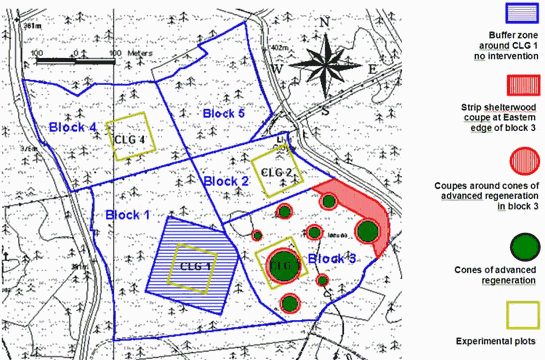
The area consists of five large plots, that total an area of 45 ha, in which the overstorey has been thinned in different ways in an attempt to produce structures analogous to different silvicultural systems. The stands were planted in the early 1950s and therefore constitute ‘late transformation’ to CCF in terms of the guidance given in Mason and Kerr (2004). This scenario is quite common in Wales and so the area is producing useful information for forest managers.
Detail on the treatments applied in large plots
Two ways in which information from these plots has informed forestry practice are:
The area contains four permanent sample plots that are producing data to support the development of project on modelling mixed-aged and mixed species stands. These plots are shown as ‘CLG’ in the map above and are valuable as the spatial location of every tree in the plots has been mapped.
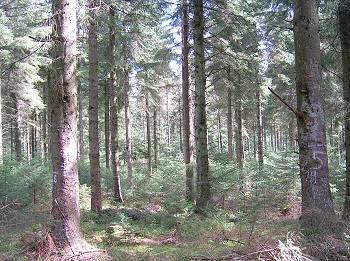
The area contains three other experimental studies:
Grassi, G. and Giannini, R. (2005). Influence of light and competition on crown and shoot morphological parameters of Norway spruce and silver fir saplings. Annals of Forest Science, 62: 269-274.
Mason, B. and Kerr, G. (2004). Transforming even-aged conifer stands to continuous cover management (PDF-88K). Forestry Commission Information Note 40. Forestry Commission, Edinburgh.
Page, L. M., Cameron, A. D. and Clarke, G. C. (2001). Influence of overstorey basal area on density and growth of advance regeneration of Sitka spruce in variably thinned stands. Forest Ecology and Management. 151: 25-35.
Pommerening, A. (2006). Evaluating structural indices by reversing forest structural analysis. Forest Ecology and Management, 224: 266–277.
Stokes, V., Kerr, G. and Ireland, D. (2009). Seedling height and the impact of harvesting operations on advance regeneration of conifer species in upland Britain. Forestry, 82:185-198.
Davies, O. and Kerr, G. (2011). Costs and Revenues of Transformation to Continuous Cover Forestry (PDF-568K). Report to the Forestry Commission by Forest Research. Alice Holt Lodge, Farnham, Surrey, England.
Gardiner, B. Leban, J. M., Auty, D. & Simpson, H. (2011). Models for predicting wood density in British-grown Sitka spruce. Forestry, 84(2):119-132.
Williams, D.T., Straw, N., Jukes, M., Fielding, N. and Price, J. (2011). Influence of forest management on bark-beetle (Scolytidae) populations inhabiting Sitka spruce plantations in Wales, UK. IUFRO WP.7.03.05 – Ecology and Management of Bark and Wood Boring Insects. Novel risks with bark and wood boring insects in broadleaved and conifer forests. Sopron, Hungary, 7-9 September 2011.
Williams, D.T., Straw, N., Fielding, N. and Price, J. (2012). Do forest management systems influence the abundance and diversity of the natural enemies associated with the green spruce aphid (Elatobium abietinum) in Sitka spruce plantations in Wales, UK. Joint IUFRO WP.7.03.10 – Methodology of forest insect and disease survey, and IUFRO WP.7.03.06 – Integrated management of forest defoliating insects, working party meeting, Palanga, Lithuania, 10-14 September 2012.
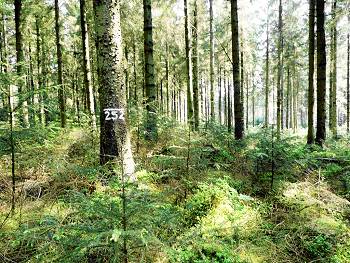
The respacing experiment was set up to establish the effects on growth and survival different respacing treatments would have on Sitka spruce natural regeneration. Two one hectare plots were established, with each of these being split further into 0.25 ha plots where each of the four respacing treatments would occur. During 2006 the following respacing treatments were carried out:
In all respacing treatments tree selection was based on both position and quality of the stem.
Plots have been sampled in each of the respacing treatments and have been sampled annually since 2009. Tree height, diameter, leader and lateral length were recorded within each of these plots. In addition to these data, whether a tree was missing (had been removed) or had died was also assessed.
Results from this study will help inform the management of natural regeneration occurring in continuous cover forestry (CCF) areas.
Clocaenog Continuous Cover Forestry (CCF) Research Area
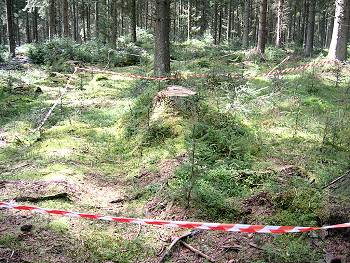
The underplanting study is investigating differences in the growth and survival of five conifer species grown under a canopy of Sitka spruce. The species chosen were Douglas-fir, noble fir, Norway spruce, European silver fir and Sitka spruce. Three plots, each containing 50 trees and with a canopy cover estimated between 50 and 70 percent, were planted for each species in 2007. Differences in growth and survival were then recorded during 2011.
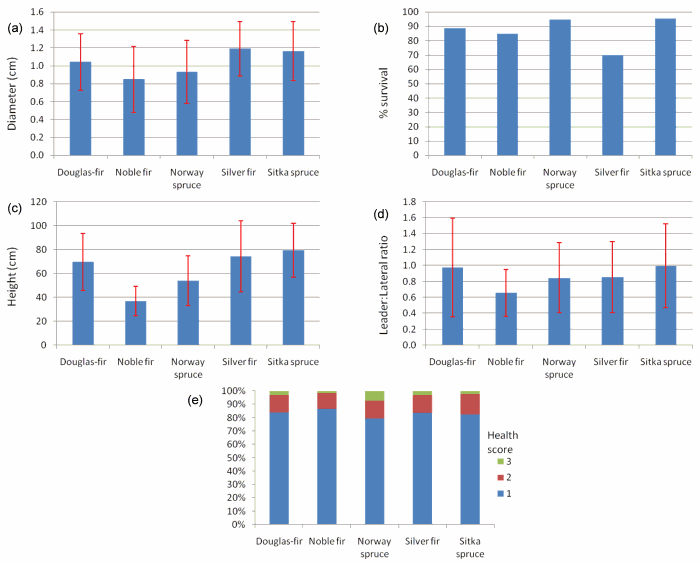
The (a) diameter, (b) % survival, (c) height, (d) Leader:Lateral ratio and (e) percentage proportion of the health score for all five species. The health score figure (e) shows the proportion of trees that are healthy (1), unhealthy (2) and unlikely to survive (3). The height, diameter and leader:lateral figures all show ± one standard deviation.
The results show Sitka spruce seedlings performed best overall; showing greater height, diameter and leader:lateral ratios than other species. Sitka spruce also showed the second-highest survival though had the second-lowest number of seedlings ranked as healthy. Conversely, Noble fir had the lowest height, leader:lateral ratio and survival. Noble fir also showed the second-lowest diameter but had the highest proportion of seedlings classed as healthy. However, it should be noted that one of the three silver fir plots was waterlogged which resulted in poor growing conditions. When the results from the waterlogged plot were excluded from the analysis, silver fir had the largest diameters and the highest survival.
The leader: lateral ratios from the experiments were all below one except for one plot of Sitka spruce, one plot of Douglas-fir and one plot of silver fir. Prior research (Page et al. 2001; Grassi and Giannini, 2005) suggests a leader:lateral ratio of one or greater would be expected in seedlings that are not light stressed. This indicates that the canopy cover in the experimental areas may be slightly too high at present.
Clocaenog Continuous Cover Forestry (CCF) Research Area
Each Block has been thinned in 2004, 2009 and 2012 aiming to achieve a residual basal area of 25 m2 ha-1. The criteria to consider for tree removal are:
The majority of this area has been thinned using the standard Forest District practice of transformation of Sitka spruce to a simple structure (one or two canopy strata). The area also contains an unthinned control, which is a 1 ha assessment plot (Labelled “CLG1” in the map of the Clocaenog experimental areas) and a 50 m surround.
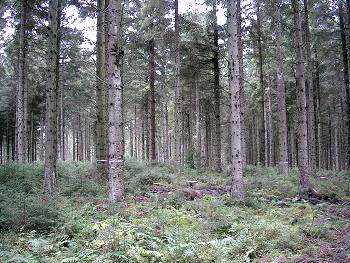
The aim in this area is to produce a more irregular stand structure and heterogeneous regeneration compared with the uniform shelterwood in Blocks 4 and 5. This is being achieved by:
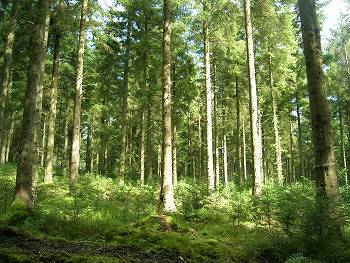
This is the most innovative treatment in any of the Blocks and is aiming to produce an irregular stand structure as quickly as possible. This is being achieved by:
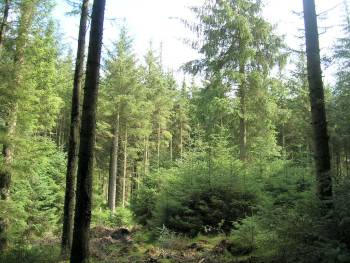
The aim of these two blocks is to produce a simple CCF structure by judicious thinning of the canopy to aid the growth and development of regeneration. To achieve this the priorities for tree removal are:
